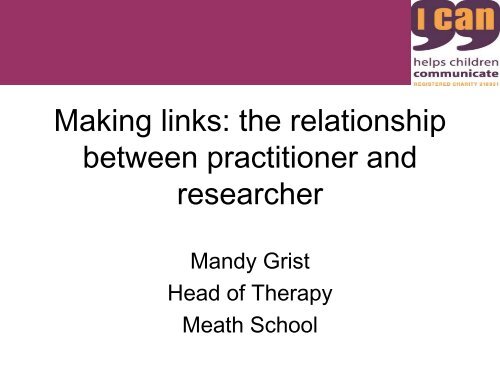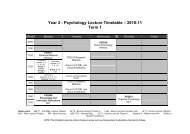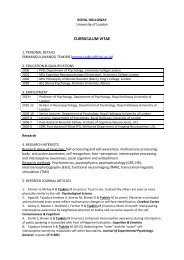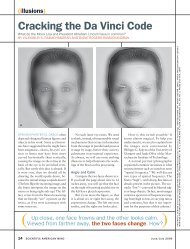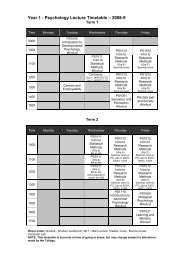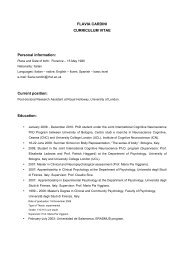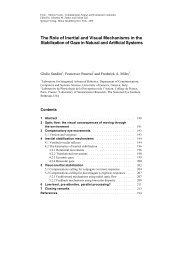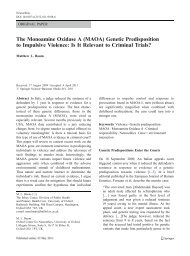Making links: the relationship between practitioner and researcher
Making links: the relationship between practitioner and researcher
Making links: the relationship between practitioner and researcher
You also want an ePaper? Increase the reach of your titles
YUMPU automatically turns print PDFs into web optimized ePapers that Google loves.
<strong>Making</strong> <strong>links</strong>: <strong>the</strong> <strong>relationship</strong><br />
<strong>between</strong> <strong>practitioner</strong> <strong>and</strong><br />
<strong>researcher</strong><br />
M<strong>and</strong>y Grist<br />
Head of Therapy<br />
Meath School
Meath School<br />
Situated in Ottershaw nr Woking in Surrey<br />
Non maintained primary school for pupils<br />
for whom severe <strong>and</strong> complex speech,<br />
language <strong>and</strong> communication needs are<br />
<strong>the</strong> primary disability<br />
Registered for 75 pupils aged 4 –11 years
10 – 12 pupils per class<br />
Each class has a core team of teacher, speech <strong>and</strong><br />
language <strong>the</strong>rapist <strong>and</strong> at least one learning support<br />
assistant<br />
Highly collaborative practice <strong>between</strong> teaching <strong>and</strong><br />
<strong>the</strong>rapy staff<br />
Class groupings according to comprehension levels,<br />
taking into account curriculum attainments <strong>and</strong> social<br />
skills
A range of speech, language <strong>and</strong><br />
communication needs including:<br />
Specific language impairment, dyspraxia,<br />
Worster Drought syndrome, mild<br />
learning difficulties, learning <strong>and</strong> social<br />
behaviours often associated with<br />
autism,attention control difficulties,<br />
L<strong>and</strong>au-Kleffner Syndrome
Opportunities throughout a pupil’s school week<br />
for individual <strong>the</strong>rapy, group <strong>the</strong>rapy <strong>and</strong><br />
class based support<br />
Work to develop many aspects of speech,<br />
language <strong>and</strong> communication skills including:<br />
Phonology, attention <strong>and</strong> listening, morphology,<br />
syntax, semantics, social interaction skills,<br />
literacy <strong>and</strong> phonological awareness skills
BUT<br />
No research currently being carried out by<br />
Meath School staff<br />
(but lots of ideas about research we<br />
would like to carry out, with some<br />
hopefully in <strong>the</strong> pipeline)
To be effective in addressing<br />
SLCN we need to do<br />
<strong>the</strong> right thing (evidence based practice)<br />
in <strong>the</strong> right way (skills <strong>and</strong> competence)<br />
<strong>the</strong> right amount<br />
at <strong>the</strong> right time<br />
in <strong>the</strong> right place<br />
with <strong>the</strong> right result (including stopping<br />
practice that is shown to be contrary to<br />
<strong>the</strong> evidence base)
The need for <strong>practitioner</strong><br />
research<br />
• Very little evidence for what works in SLCN<br />
• But <strong>practitioner</strong>s have experience which may not be<br />
shared<br />
• Need to build a body of case studies to identify what<br />
might work, which can <strong>the</strong>n be tested fur<strong>the</strong>r<br />
• We need to see if what works in experimental<br />
conditions also works in practice<br />
• To show <strong>the</strong> effectiveness of our work<br />
• As an extension of self reflection <strong>and</strong> service<br />
improvement which occurs anyway
The need to discuss <strong>and</strong><br />
underst<strong>and</strong> research<br />
•Practitioners need to be able to put<br />
research into practice<br />
•Be wary of<br />
–Small samples<br />
–Unspecified ‘<strong>the</strong>rapy/teaching’<br />
–Things that work but are impractical in real<br />
settings<br />
–Mixed groups of SLI/SLCN; <strong>the</strong>y are all<br />
different
Why intervention research is<br />
tricky<br />
•Children with SLCN are all different, so how<br />
can you match groups<br />
•Access to literature is limited<br />
•Ethical issues, if we’re not sure it will help<br />
children, should we be doing it<br />
•Those who do <strong>the</strong> <strong>the</strong>rapy or teaching<br />
shouldn't be <strong>the</strong> ones who assess <strong>the</strong><br />
outcomes<br />
•It takes time <strong>and</strong> money
Why collaboration is vital<br />
Evidence based practice is a<br />
two way process <strong>between</strong><br />
research <strong>and</strong> practice <strong>and</strong> is<br />
needed to prove efficacy <strong>and</strong><br />
effectiveness<br />
Judy Clegg
LiLaC will provide<br />
opportunities for<br />
•Practitioners <strong>and</strong> <strong>researcher</strong>s to share ideas <strong>and</strong><br />
knowledge<br />
•Discussion <strong>and</strong> dissemination of research<br />
•Highlighting implications for practice<br />
•Fostering of collaborations <strong>between</strong> <strong>researcher</strong> <strong>and</strong><br />
<strong>practitioner</strong><br />
•Broadening our underst<strong>and</strong>ing <strong>and</strong> knowledge of<br />
language, literacy <strong>and</strong> communication difficulties<br />
•Linking research <strong>and</strong> practice
What about you<br />
Your thoughts/experiences
Thank you<br />
mgrist@meath-ican.org.uk
LiLaC research: an<br />
overview<br />
Courtenay Frazier Norbury<br />
RCUK Research Fellow
talk plan<br />
• overview of previous research<br />
• future directions for LiLaC<br />
• why I’ve established this workshop<br />
• overview of <strong>the</strong> afternoon
Big Questions<br />
• Why is language vulnerable across<br />
developmental disorders<br />
• What does impaired language mean for<br />
o<strong>the</strong>r aspects of cognitive development<br />
• What can we do about impaired language<br />
development
Therapy/Education!<br />
adapted from Morton & Frith (1995)
Specific Language<br />
Impairment (SLI)<br />
Autism Spectrum<br />
Disorder (ASD)<br />
social interaction<br />
restricted interests<br />
language<br />
communication<br />
syntax<br />
morphology<br />
phonology<br />
semantics<br />
Social difficulties<br />
become more evident<br />
over time<br />
pragmatics<br />
Structural language abilities are<br />
extremely variable – what difference<br />
does language make
Group selection process<br />
Autism<br />
NO<br />
YES<br />
Language Impairment<br />
YES YES NO<br />
Language<br />
Impaired<br />
(SLI)<br />
Autistic<br />
Spectrum +<br />
LI (ALI)<br />
Autistic<br />
Spectrum –<br />
LI (ALN)
Group selection process<br />
Autism<br />
NO<br />
YES<br />
Language Impairment<br />
YES YES NO<br />
Language<br />
Impaired<br />
(SLI)<br />
Autistic<br />
Spectrum +<br />
LI (ALI)<br />
Autistic<br />
Spectrum –<br />
LI (ALN)
Eye-tracking<br />
• Tend to look at what we are thinking about<br />
• Language can fur<strong>the</strong>r direct visual attention<br />
• In general, <strong>relationship</strong> <strong>between</strong> amount of time<br />
one spends looking at something <strong>and</strong> ‘cognitive<br />
load’<br />
• Therefore, can implicitly measure<br />
language/social processing in real time by<br />
measuring eye-movements as we vary<br />
linguistic/social stimuli
Stimuli:<br />
Still image/video<br />
camera
Norbury, Brock, Cragg, Einav & Nation Journal of<br />
Child Psychology <strong>and</strong> Psychiatry, 2009<br />
region of<br />
interest<br />
fixation<br />
3<br />
5<br />
2<br />
switch in<br />
visual attn<br />
1<br />
4
eye-tracking study<br />
(Brock, Norbury, Einav & Nation, Cognition, 2008)<br />
Sam chose <strong>the</strong> hamster carefully<br />
Joe stroked <strong>the</strong> hamster quietly<br />
target present<br />
target absent
effect of sentence context on competitor fixations<br />
Joe stroked <strong>the</strong> hamster quietly<br />
Probability of fixation<br />
0.5<br />
0.4<br />
0.3<br />
0.2<br />
0.1<br />
Log odds of fixation on competitor<br />
0.5<br />
0<br />
-0.5<br />
-1<br />
-1.5<br />
-2<br />
R 2 =.216, p=.001<br />
0<br />
0 200 400 600 800 1000<br />
Time since target onset / msecs<br />
-2.5<br />
60 70 80 90 100 110 120<br />
Language composite<br />
Control Autism Autism TD LI
what next
Research agenda: I<br />
• Eye-tracking studies: at what point does<br />
language break down<br />
– Word learning<br />
• Contrast social (eye-gaze) <strong>and</strong> linguistic (verb<br />
semantics) cues to word learning<br />
– Language production<br />
• Organisation of language output<br />
– Semantic networks<br />
• do children automatically access meaningfully<br />
related words in response to a target word<br />
– Social attention<br />
• Do gaze patterns vary according to<br />
linguistic/cognitive load
Research agenda: II<br />
• Longitudinal studies: when <strong>and</strong> why do<br />
differences in development occur<br />
– School entry:<br />
• Assessing screening measures for identifying SLI<br />
• Assessing degree of comorbidity in population<br />
sample<br />
• Assessing impact of LI on educational<br />
achievement <strong>and</strong> behaviour in first year of formal<br />
schooling<br />
– High-risk infants:<br />
• Infant siblings of children with autism compared<br />
with infant siblings of children with SLI
Research agenda: III<br />
• Genetics<br />
– Recent breakthroughs in:<br />
• specific genes that are associated with particular<br />
language skills (i.e. phonological short-term<br />
memory)<br />
• testable hypo<strong>the</strong>ses about how <strong>the</strong>se genes may<br />
alter brain development at <strong>the</strong> earliest stages<br />
• some suggestion that similar genes may be<br />
implicated in ‘distinct’ disorders<br />
– BUT: lots of noise (comorbidity <strong>and</strong> diagnostic<br />
discrepancies)<br />
• need population cohort <strong>and</strong> st<strong>and</strong>ardised<br />
diagnostic approach<br />
• Hopefully, we’ll be one of 5 UK centres to help<br />
recruit largest SLI sample in <strong>the</strong> world
Research agenda: IV<br />
• Intervention: different approaches needed<br />
to improve apparently similar language<br />
deficits across disorders<br />
– role of verbs in predicting what next<br />
– inferring information from context<br />
– learning words social/linguistic context<br />
– implicit vs explicit learning of grammar<br />
– developing narrative skills<br />
– if you’re interested let me know!
why LiLaC workshops<br />
• Desire to establish a <strong>researcher</strong>-<strong>practitioner</strong><br />
network:<br />
– forum to disseminate research findings that may be of<br />
practical use/interest to <strong>practitioner</strong>s<br />
– forum to learn more about <strong>practitioner</strong><br />
initiatives/policies that are relevant to <strong>the</strong> field<br />
– information <strong>and</strong> advice from <strong>practitioner</strong>s in<br />
developing research studies that are beneficial<br />
– initiate new research projects to improve evidence<br />
base<br />
– facilitate recruitment <strong>and</strong> implementation of research<br />
studies
est of <strong>the</strong> day (a taster session)...<br />
• M<strong>and</strong>y Grist: complex LI in a special<br />
educational context<br />
• Pat Robinson: local literacy initiative in<br />
children with complex LI<br />
• Anne Sheddick: services on offer at<br />
Dyslexia Action<br />
• Vicky Slonims: implementing intervention<br />
research in <strong>the</strong> real world<br />
• Discussion: your chance to tell us what<br />
you want out of <strong>the</strong>se workshops
Language <strong>and</strong> literacy<br />
Pat Robinson<br />
Assistant Head<br />
I CAN Centre with Meath School
• very strong link <strong>between</strong> SLCN <strong>and</strong> literacy problems<br />
•Longitudinal study by Bishop <strong>and</strong> Adams (1990)<br />
– critical age of 5.5yrs for resolution of language difficulties <strong>and</strong><br />
impact on reading <strong>and</strong> spelling skills<br />
•Decline in levels of children’s oral language skills when <strong>the</strong>y start<br />
school ( Basic Skills Agency 2002)<br />
•Many children start learning to read with a shaky foundation in<br />
language ( Stackhouse J 1989)
What are <strong>the</strong> difficulties<br />
•Almost all children with SLCN had difficulty with some aspect of<br />
literacy<br />
- decoding print<br />
-reading comprehension<br />
-spelling<br />
-written language skills
semantics<br />
orthography<br />
phonology
Why do children with a<br />
Communication Disability find<br />
phonological skills so difficult<br />
Poor listening <strong>and</strong> attention<br />
Difficulties with sound discrimination<br />
- Identifying <strong>the</strong> boundaries <strong>between</strong> sounds<br />
- Hearing <strong>the</strong> difference <strong>between</strong> sounds<br />
- Particular difficulty with vowel sounds
Why do children with a<br />
Communication Disability find<br />
phonological skills so difficult<br />
Language<br />
We use language to talk about phonics<br />
Children who have difficulties underst<strong>and</strong>ing <strong>and</strong> using language<br />
are at an immediate disadvantage<br />
Sounds are abstract, <strong>the</strong>y don’t carry any intrinsic meaning –<br />
difficult to underst<strong>and</strong>, retain <strong>and</strong> recall<br />
Concepts e.g. first / next / middle / last<br />
letter sound / letter name
Why do children with a<br />
Communication Disability find<br />
phonological skills so difficult<br />
Memory<br />
“This study has established substantial deficits in immediate memory for verbal<br />
materials in children with SLI. The most marked impairments were on measures<br />
of working memory <strong>and</strong> verbal short term memory.”<br />
(Archibald <strong>and</strong> Ga<strong>the</strong>rcole 2006)<br />
Verbal short term memory – remembering <strong>and</strong> recalling sounds <strong>and</strong> sequences<br />
Working memory – retaining sounds <strong>and</strong> ‘working’ with <strong>the</strong>m<br />
b e d
Why do children with a<br />
Communication Disability find<br />
phonological skills so difficult<br />
Speech difficulties<br />
Some children have difficulties producing <strong>the</strong> sounds of speech<br />
They don’t get accurate <strong>and</strong> consistent motor feedback when<br />
learning sounds<br />
-Significant risk of difficulties with phonics<br />
-Find blending / segmenting very difficult to do independently<br />
-Most learn to read using predominantly visual strategies
Written language difficulties<br />
•Poor organisation<br />
•Short simple sentence constructions<br />
•Limited use of vocabulary<br />
•No opportunity for using additional cues to<br />
support <strong>the</strong> written word
What skills do you need<br />
He shivered in <strong>the</strong> cold wind <strong>and</strong> pulled his<br />
jacket tighter. Anxiously he looked down <strong>the</strong><br />
road, while he waited for <strong>the</strong> o<strong>the</strong>rs. He<br />
jingled <strong>the</strong> money in his pocket, enough for<br />
his ticket but not enough for popcorn as<br />
well.
Literacy intervention at<br />
Meath School<br />
•Daily language <strong>and</strong> literacy sessions<br />
•Planned <strong>and</strong> delivered collaboratively by teacher, SLT <strong>and</strong> TA<br />
•Primary Framework for Literacy objectives differentiated <strong>and</strong><br />
tailored to meet needs<br />
•Addresses phonological, syntactical <strong>and</strong> semantic profiles of need<br />
•Visual/multi – sensory support systems
How do we begin<br />
• A visual timetable as <strong>the</strong> framework<br />
•Used daily<br />
•Builds language using <strong>the</strong> context of child’s environment<br />
•Child centred to build on existing skills<br />
•Reinforces key vocabulary
Drawing <strong>the</strong> timetable at <strong>the</strong><br />
beginning of <strong>the</strong> day
Drawing of activity in each box –<br />
picture to picture matching
Matching word to drawing
Drawing with 2 words
Photo with 2 element choices
Constructing a sentence with<br />
multiple choices
Practical Strategies – Colour Coding<br />
Charlotte is not sitting comfortably on <strong>the</strong><br />
small chair because it is too wobbly.<br />
Proper Nouns <strong>and</strong> pronouns – pink<br />
Nouns – orange<br />
Verbs – yellow<br />
Adjectives – green<br />
Conjunctions – purple<br />
Intensifiers – red<br />
Determiners – black<br />
Adverbs – brown<br />
Prepositions – blue<br />
Primary Framework Year 1 Speaking<br />
‘Experiment with <strong>and</strong> build new stores of words to communicate in different contexts.’
Practical Strategies – Colour Coding
Practical Strategies<br />
THRASS – Teaching H<strong>and</strong>writing, Reading And Spelling Skills<br />
Speaking <strong>and</strong> listening skills are taught from <strong>the</strong><br />
outset using pictures <strong>and</strong> key words on a whole<br />
picture chart.<br />
All 44 phonemes (speech sounds) <strong>and</strong> 120 key<br />
graphemes (spelling choices) are included.<br />
Lower case <strong>and</strong> capital letters are identified by name<br />
alongside letter sounds.<br />
Primary Framework Year 1 Word Recognition – ‘recognise <strong>and</strong> use<br />
alternative ways of pronouncing/spelling <strong>the</strong> graphemes already taught .’
Piecing it all toge<strong>the</strong>r
26 th March 2009<br />
Anne Sheddick Dyslexia Action E guides National Conference Nottingham<br />
tingham
This Presentation<br />
‣ Who are we<br />
‣ What do we do<br />
‣ Why do we do it<br />
‣ How do we do it<br />
‣ Questions <strong>and</strong> Discussion<br />
April 2009<br />
Anne Sheddick RHUL Lilac meeting
Dyslexia Action -Who we are<br />
‣ A medium sized National Charity<br />
‣ Mission to support <strong>and</strong> enable dyslexic<br />
people of all ages to meet <strong>the</strong>ir potential<br />
‣ Teach children <strong>and</strong> adults<br />
‣ Assess children <strong>and</strong> adults<br />
‣ Train Teachers<br />
‣ Projects with partners<br />
‣ Lobby government<br />
April 2009<br />
Anne Sheddick RHUL Lilac meeting
Teach children <strong>and</strong> Adults<br />
‣ 43 teaching centres around <strong>the</strong> UK<br />
‣ 150 outposts- increasingly based in<br />
Schools<br />
‣ 250 specialist teachers<br />
‣ Teaching programmes based around DILP<br />
<strong>and</strong> Units of Sound<br />
‣ Teaching programmes range from 1-11<br />
1 to<br />
group work<br />
‣ Support for parents<br />
April 2009<br />
Anne Sheddick RHUL Lilac meeting
Assessment<br />
‣ EP assessments – nationally through centres<br />
‣ Specialist teacher assessments - nationally<br />
‣ Assessments for Universities, Colleges,<br />
Organisations ( Cos, NHS, Met, Prisons etc) for<br />
DSA<br />
‣ Training Assessors – PG <strong>and</strong> CCET<br />
‣ Training for ‘Exam Access arrangements’<br />
‣ CPD- update training for assessors<br />
‣ Dyslexia Action Guild- Issues Practising<br />
Certificates for ‘Specialist Teacher’ Assessors<br />
April 2009<br />
Anne Sheddick RHUL Lilac meeting
Projects<br />
‣ Partnership for Literacy<br />
• Government support<br />
• 50 schools – primary<br />
• Goal 250 schools by end of 2010<br />
• To include secondary<br />
‣ IDP – Inclusion Development Programme<br />
• DCSF – funded Dyslexia Action for development <strong>and</strong> implementation<br />
• National roll out underway.<br />
‣ LSC projects<br />
• HDQ- with prisons<br />
• Maths training<br />
• Use of technology- EU project<br />
• TDA – CPD for literacy <strong>and</strong> teacher development linked to St<strong>and</strong>ards<br />
‣ Pedagogy - with TLRP <strong>and</strong> GTC<br />
April 2009<br />
Anne Sheddick RHUL Lilac meeting
Government Liaison<br />
‣ CEO, Press office <strong>and</strong> senior staff<br />
• All party Parliamentary committee on SPLD –<br />
DA provides <strong>the</strong> secretariat<br />
• Relationships with ministers <strong>and</strong> civil servants<br />
• Relationships with <strong>the</strong> press<br />
• Membership of key bodies _ eg LSC, GTC etc<br />
• Rose Review<br />
• Government projects- dissemination<br />
April 2009<br />
Anne Sheddick RHUL Lilac meeting
Our Training-What do we do<br />
‣ 600 students approximately nationally <strong>and</strong> internationally<br />
‣ Post graduate- Undergraduate level, <strong>and</strong> CPD<br />
‣ Validated by University of York <strong>and</strong> Open University<br />
‣ Partnership with University of Reading<br />
‣ Move to delivery via blended e-learninge<br />
‣ Needed to update, reach wider market, improve support,<br />
ensure cost viability<br />
‣ DA support on e-courses e<br />
second to none<br />
‣ Heavy investment <strong>and</strong> priority given to tutor support<br />
‣ Practical skills – face to face <strong>and</strong> innovative technology<br />
April 2009<br />
Anne Sheddick RHUL Lilac meeting
Our courses<br />
‣ Postgraduate Certificate <strong>and</strong> Diploma in<br />
Dyslexia <strong>and</strong> literacy<br />
‣ Supporting Adults – level 4<br />
‣ Hornsby 1 year course – level 4<br />
‣ Mainstream Teachers – level 4<br />
‣ Teaching Assistants<br />
‣ Maths<br />
‣ CCET<br />
‣ CPD<br />
And <strong>the</strong>n - Projects<br />
April 2009<br />
Anne Sheddick RHUL Lilac meeting
IDP<br />
‣ 4 projects, 4 models - Cornwall, (PH),<br />
Gateshead, Hull, London<br />
‣ Partnership with National Strategies<br />
‣ Fur<strong>the</strong>r work to roll out to all English schools<br />
beyond <strong>the</strong> project<br />
‣ Liaison with Regional Hubs <strong>and</strong> LAs- all have<br />
money for national rollout<br />
‣ Evaluation through University of Warwick<br />
‣ Autism, ADHD <strong>and</strong> o<strong>the</strong>r SPLDs recently<br />
launched<br />
‣ Follow up <strong>and</strong> consolidation 2010 onwards<br />
April 2009<br />
Anne Sheddick RHUL Lilac meeting
Our training Courses -Why E- E<br />
learning<br />
‣ introduction of E-learning E<br />
– 2007<br />
• Need to make courses accessible to as wide an<br />
audience as possible<br />
• To meet <strong>the</strong> needs of individuals <strong>and</strong> organisations<br />
<strong>and</strong> <strong>the</strong>ir professional dem<strong>and</strong>s<br />
• To enhance learning<br />
• To improve support<br />
• Blended learning<br />
• To build communities of practice<br />
• International reach<br />
April 2009<br />
Anne Sheddick RHUL Lilac meeting
Guiding principles<br />
‣ Determined to create <strong>and</strong> deliver courses which<br />
• are led by pedagogy <strong>and</strong> not technology<br />
• ensures integration of <strong>the</strong>ory <strong>and</strong> practice<br />
• develops practical teaching <strong>and</strong> skills for learner<br />
assessment on line<br />
• develops critical analysis <strong>and</strong> enquiry<br />
• improves support to <strong>and</strong> reduces isolation of students<br />
• improves support to <strong>and</strong> reduces isolation of tutors<br />
This means<br />
April 2009<br />
Anne Sheddick RHUL Lilac meeting
E-learning<br />
‣ Development of expertise<br />
• in E learning course design<br />
• Creating <strong>and</strong> delivering <strong>the</strong> blend<br />
• Course tutor support<br />
‣ Focus on<br />
• pedagogy<br />
• development of practical skills<br />
• Linking of <strong>the</strong>ory to practice<br />
• Reflective practice<br />
Both <strong>the</strong> How to <strong>and</strong> <strong>the</strong> Why<br />
‣<br />
April 2009<br />
Anne Sheddick RHUL Lilac meeting
Pedagogy not Technology<br />
Seven key Questions<br />
1. Which VLE to use<br />
2. What teaching <strong>and</strong> course design approaches<br />
to take<br />
3. How to manage <strong>the</strong> course development<br />
process<br />
4. How to train staff to create <strong>and</strong> deliver <strong>the</strong><br />
courses<br />
5. Personnel, legal <strong>and</strong> financial issues<br />
6. How to select <strong>the</strong> right learning/teaching<br />
strategy for different parts of <strong>the</strong> course<br />
April 2009<br />
Anne Sheddick RHUL Lilac meeting
Multiple levels of learning <strong>and</strong> Mastery require different learning strategies<br />
Novice<br />
Competent<br />
Experienced<br />
<strong>practitioner</strong><br />
Master expert<br />
Training<br />
Coaching<br />
Access to<br />
information<br />
& resources<br />
Collaboration<br />
& problem<br />
solving<br />
Show me how<br />
Help me improve<br />
Help me find<br />
what I need<br />
I create <strong>and</strong> share my<br />
own learning<br />
Common learning needs<br />
Formal structures<br />
Unique learning needs<br />
Professional context<br />
Common Curriculum<br />
Personalized learning<br />
Adapted from Marc Rosenberg, Beyond E learning, Lisbon E learning conference October 2008<br />
April 2009<br />
Anne Sheddick RHUL Lilac meeting
The position in 2005-6<br />
Total turnover<br />
approx £450K<br />
Loss approx £175 K<br />
PG attendance<br />
Small surplus<br />
PG DL<br />
Major losses &<br />
TDA liability<br />
OCN<br />
Hornsby, Adults,TAs etc<br />
Small losses<br />
CPD<br />
Govt<br />
contracts<br />
LSC<br />
Break even<br />
CCET – Access arrangements<br />
April 2009<br />
Anne Sheddick RHUL Lilac meeting
Contact details<br />
Anne Sheddick<br />
Head of Training<br />
asheddick@dyslexiaaction.org.uk<br />
www.d<br />
.dyslexiaaction.org.uk<br />
April 2009<br />
Anne Sheddick RHUL Lilac meeting
April 2009<br />
Anne Sheddick RHUL Lilac meeting
Social skills: can we teach <strong>the</strong>m<br />
How do we measure <strong>the</strong>m<br />
Dr Vicky Slonims
Plan<br />
• Review of <strong>the</strong> literature<br />
• History of efforts to implement <strong>and</strong> measure<br />
social skills interventions<br />
• What do we teach<br />
• Guy’s social skills groups
Teaching Social Skills<br />
• Michael Argyle pioneer of social psychology in 1950s<br />
broke new ground with studies of non-verbal<br />
communication <strong>and</strong> social skills<br />
• Hypo<strong>the</strong>ses <strong>and</strong> experiments to examine which nonverbal<br />
cues served which interactive social functions <strong>and</strong><br />
how<br />
• Conceptualised <strong>the</strong> crucial components of social<br />
interaction <strong>and</strong> translated <strong>the</strong>se into training<br />
programmes for <strong>the</strong> workplace <strong>and</strong> everyday living.<br />
• The phrase "social skills" is now commonplace
Social skills training in ASD<br />
• Much of research relates to business, socially<br />
inadequate individuals, shyness etc<br />
• Results indicate good outcomes for <strong>the</strong> above<br />
• What about individuals with autism spectrum<br />
disorders <br />
Social intuition<br />
Generalisation<br />
Motivation
•<br />
Social Skills Groups<br />
Barry, TD; Klinger LG, Lee JM, Palardy N, GilmoreT, BodinSD. Examining<br />
<strong>the</strong> effectiveness of an outpatient clinic based social skills group for<br />
high-functioning children with autism Journal of Autism <strong>and</strong><br />
Developmental Disorders. Vol 33(6) Dec 2003, 685-701.<br />
Bauminger N. The facilitation of social-emotional underst<strong>and</strong>ing <strong>and</strong><br />
social interaction in high-functioning children with autism: Intervention<br />
outcomes. Journal of Autism <strong>and</strong> Developmental Disorders. Vol 32(4) Aug<br />
2002, 283-298.<br />
Chung Kyong-Mee,Reavis S, Mosconi M,Drewry J, Mat<strong>the</strong>ws T, Tasse MJ.<br />
Peer-mediated social skills training program for young children with<br />
high-functioning autism Research in Developmental Disabilities. Vol 28(4)<br />
Jul 2007, 423-436.<br />
Givers C, CliffordP, Mager M, Boer F. Brief Report: A Theory-of-Mindbased<br />
Social-Cognition Training Program for School-Aged Children<br />
with Pervasive Developmental Disorders: An Open Study of its<br />
Effectiveness Journal of Autism <strong>and</strong> Developmental Disorders. Vol 36(4)<br />
May 2006, 567-571.
Social Skills Groups cont<br />
Marriage KJ, Gordon V, Br<strong>and</strong> L. A social skills group for boys with<br />
Asperger's syndrome. Australian <strong>and</strong> New Zeal<strong>and</strong> Journal of<br />
Psychiatry. Vol 29(1) Mar 1995, 58-62.<br />
Ozonoff S, Miller JN. Teaching <strong>the</strong>ory of mind: A new approach to<br />
social skills training for individuals with autism. Journal of Autism<br />
<strong>and</strong> Developmental Disorders. Vol 25(4) Aug 1995, 415-433.<br />
Trimarchi CL. 2004 The implementation <strong>and</strong> evaluation of a social<br />
skills training program for children with asperger syndrome<br />
Dissertation Abstracts International: Section B: The Sciences <strong>and</strong><br />
Engineering. Vol 65(5-B), 2004, pp. 2655.<br />
Webb BJ, Miller SP, Pierce TB, Strawser S, Jones WP. Effects of<br />
Social Skill Instruction for High-Functioning Adolescents with<br />
Autism Spectrum Disorders Focus on Autism <strong>and</strong> O<strong>the</strong>r<br />
Developmental Disabilities. Vol 19(1) Spr 2004, 53-62.
Computer based interventions<br />
• Hopkins, IM. Demonstration <strong>and</strong> evaluation of avatar assistant:<br />
Encouraging social development in children with autism spectrum<br />
disorders. Dissertation Abstracts International: Section B: The Sciences<br />
<strong>and</strong> Engineering. Vol 68(5-B), 2007, pp. 3424.<br />
• Parsons S, Leonard A, Mitchell P. Virtual environments for social skills<br />
training: Comments from two adolescents with autistic spectrum<br />
disorder. Computers & Education. Vol 47(2) Sep 2006, 186-206.<br />
• Simpson A, Langone J Ayres K M. Embedded Video <strong>and</strong> Computer<br />
Based Instruction to Improve Social Skills for Students with Autism.<br />
Education <strong>and</strong> Training in Developmental Disabilities. Vol 39(3) Sep 2004,<br />
240-252.<br />
• Swettenham J. Can children be taught to underst<strong>and</strong> false belief using<br />
computers Journal of Child Psychology <strong>and</strong> Psychiatry. Vol 37(2) Feb<br />
1996, 157-165.
Peer/sibling training interventions<br />
• Bass JD, Mulick JA. Social play skill enhancement of children<br />
with autism using peers <strong>and</strong> siblings as <strong>the</strong>rapists. Psychology<br />
in <strong>the</strong> Schools. Vol 44(7) Sep 2007, 727-735.<br />
• Odom SL, Watts E. Reducing teacher prompts in peer-mediated<br />
interventions for young children with autism. The Journal of<br />
Special Education. Vol 25(1) Spr 1991, 26-43.
School based interventions<br />
• Bellini S, Peters JK, Benner L, Hopf A. A meta-analysis of schoolbased<br />
social skils interventions for children with autism<br />
spectrum disorders Remedial <strong>and</strong> Special Education. Vol 28(3)<br />
May-Jun 2007, 153-162.<br />
• Scattone D. Social skills interventions for children with autism.<br />
Psychology in <strong>the</strong> Schools. Vol 44(7) Sep 2007, 717-726<br />
• Yang NK; Huang T, Schaller JL, Wang MH, Tsai S. Enhancing<br />
appropriate social behaviours for children with Autism in<br />
general education classrooms: An analysis of six cases<br />
Education <strong>and</strong> Training in Developmental Disabilities. Vol 38(4) Dec<br />
2003, 405-416.
Individual training for young children<br />
• Baron-Cohen S, Hill J, Golan JO, Wheelwright S, (2002)<br />
Mindreading Made Easy Cambridge Medicine 17:28-29<br />
• Hadwin J, Baron-Cohen S, Howlin P, H Katie. Can we teach children<br />
with autism to underst<strong>and</strong> emotions, belief, or pretence Development<br />
<strong>and</strong> Psychopathology. Vol 8(2) Spr 1996, 345-365.<br />
• Golan O, Baron-Cohen S, Wheelwright S,Hill JJ, (2006)<br />
Systemizing empathy: Teaching adults with Asperger Syndrome <strong>and</strong><br />
High Functioning Autism to recognize complex emotions using<br />
interactive multimedia.<br />
• Gutstein SE, Burgess AF, Montfort K. Evaluation of <strong>the</strong> Relationship<br />
Development Intervention Program Autism. Vol 11(5) Sep 2007, 397-<br />
411.<br />
• Quill KA. Visually cued instruction for children with autism <strong>and</strong><br />
pervasive developmental disorders. Focus on Autistic Behavior. Vol<br />
10(3) Aug 1995, 10-20.
Adult training/vocational training<br />
• Hillier A, Fish T, Cloppert P, Beversdorf DQ. Outcomes of a social<br />
<strong>and</strong> vocational skills support group for adolescents <strong>and</strong> young<br />
adults on <strong>the</strong> autism spectrum Focus on Autism <strong>and</strong> O<strong>the</strong>r<br />
Developmental Disabilities. Vol 22(2) Sum 2007, 107-115.<br />
• Howlin P, Yates P. The potential effectiveness of social skills<br />
groups for adults with autism. Autism. Vol 3(3) Sep 1999, 299-<br />
307.
Barry et al<br />
Journal of Autism <strong>and</strong> Developmental Disorders<br />
<br />
<br />
<br />
<br />
<br />
clinic-based social skills 4 HFA 6-9 yrs + 7 typical peers<br />
8, 2hr sessions once per week<br />
Measures:<br />
• Social Skills Rating System (SSRS) Gresham & Elliot 1990<br />
• Social skills obs 2 x 5 mins rated on study specific measure 36 skills related to<br />
intervention <strong>and</strong> 7 non-targeted at end of each session<br />
• Parental interview (Qs relating to above skills)<br />
• Self rating scales<br />
Social Support Scale for Children (Harter 1985)<br />
Loneliness Scale (Asher & Wheeler 1985)<br />
Intervention:<br />
• specific social skills, including greeting, conversation, <strong>and</strong> play skills in a brief <strong>the</strong>rapy<br />
format.<br />
• Typical peers received education about ways to interact with children with autism.<br />
Results:<br />
• intervention was effective ↑ improving greeting <strong>and</strong> play skills in context of session with<br />
peer<br />
• less clear improvements noted in conversation as rated by parents but +ve re: greeting<br />
skills.<br />
• Children with HFA reported increased feelings of social support from classmates.
Ozonoff S, Miller JN<br />
Journal of Autism <strong>and</strong> Developmental Disorders.<br />
• 41/2 month intervention<br />
Teaching specific TOM skills<br />
Specific interaction <strong>and</strong> conversational skills<br />
• Participants:<br />
2 groups of ASD matched for IQ <strong>and</strong> severity of Autism (age range 13-14)<br />
• Measures:<br />
TOM measures e.g. false belief <strong>and</strong> 2 nd order belief tasks<br />
SSRS Gresham & Elliot T <strong>and</strong> Parent versions<br />
• Intervention:<br />
Weekly 41/2 months (14 sessions) including teaching <strong>and</strong> video tapes role plays<br />
• Results:<br />
TOM - medium to large effect sizes for treatment group but not controls<br />
SSRS – no effect
Bauminger N.<br />
Journal of Autism <strong>and</strong> Developmental Disorders<br />
• 7 month CBT on social emotional underst<strong>and</strong>ing + social interaction<br />
• 3 hrs per week with class teacher <strong>and</strong> assigned typically developing peer +<br />
child’s parents<br />
• Practice sessions with peer 2 per week<br />
• Participants:<br />
15, 8-17 year olds with HFA<br />
• Measures:<br />
Problem solving measure (Lochman & Lampron 86)<br />
Emotion Inventory (Seidner, Stipek & Feshback 88)<br />
Direct observations with peer 2 x 15 mins pre <strong>and</strong> 2 x 15 mins after each group<br />
(on 4 occasions)<br />
• Behaviour coding scheme Huack 95<br />
• SSRS Teacher scales<br />
• Results:<br />
Improvements on emotional underst<strong>and</strong>ing <strong>and</strong> knowledge<br />
Children with HFA ↑initiate <strong>and</strong> respond to peers, ↑ eye contact, ↑ talk to express<br />
<strong>and</strong> interest, ↑ sharing of experiences ↓ritualistic behaviours<br />
SSRS ↑ cooperation <strong>and</strong> assertion scales<br />
• Problems:<br />
No control group<br />
Non-blind observers<br />
Teachers were involved in both intervention <strong>and</strong> evaluation
08/09 Research<br />
• TOM – single case study<br />
• LEGO vs SULP + no treatment Baron-Cohen group<br />
• Junior Detective Training Programme<br />
• CO-OP - cognitive orientation to daily occupational performance<br />
• TEACCH<br />
• Social stories X 4<br />
• Manualised social skills intervention<br />
• Use of peers X 5<br />
• Video interventions
Summary of research<br />
• Positive outcomes primarily for<br />
Withdrawn socially deprived children<br />
Unpopular children<br />
Aggressive/conduct or ADHD<br />
Learning disabilities<br />
ASD always come out at <strong>the</strong> bottom or no effect<br />
• Problems associated with social skills training<br />
Circumscribed nature of <strong>the</strong> skills taught<br />
Limited evaluation,<br />
Problems of generalisation <strong>and</strong> maintenance in real-life settings<br />
Problems in encouraging <strong>the</strong> use <strong>and</strong> development of such programmes<br />
by care staff, teachers <strong>and</strong> o<strong>the</strong>rs
Teaching required – Autism<br />
• Tolerating o<strong>the</strong>r children in close proximity<br />
• Offering toys/negotiating swapping<br />
• Work on turn taking, group participation<br />
(We<strong>the</strong>rby <strong>and</strong> Prizant)<br />
• What is <strong>the</strong> motivation
Problems in Asperger syndrome<br />
• Awareness of<br />
listener needs<br />
• Choice of topics<br />
• Turn taking<br />
• Breakdown <strong>and</strong><br />
repair<br />
• Theme development<br />
• Topic maintenance<br />
• Social comments<br />
• Questions <strong>and</strong><br />
curiosity<br />
• Pedantic <strong>and</strong> literal<br />
• Over sophisticated<br />
vocabulary<br />
• Intrusiveness of<br />
interests<br />
• Reciprocity <strong>and</strong><br />
responsiveness
Social skills associated with friendships<br />
• Entry skills<br />
• when <strong>and</strong> how to join in<br />
• <strong>the</strong> welcome provided<br />
• Assistance<br />
• when <strong>and</strong> how<br />
• seeking assistance<br />
• Criticism<br />
• appropriate<br />
• tolerance of<br />
• Compliments<br />
• appropriate<br />
• responding to<br />
• Accepting suggestions<br />
• incorporating ideas<br />
• indicating agreement<br />
• Reciprocity <strong>and</strong> sharing<br />
• equitable distribution of<br />
conversation<br />
• Conflict resolution<br />
• compromising<br />
• accepting<br />
• no aggression or immaturity<br />
• Monitoring <strong>and</strong> listening<br />
• observing o<strong>the</strong>rs<br />
• monitoring self<br />
• Empathy<br />
• Avoiding <strong>and</strong> ending<br />
• appropriate<br />
• endings
Does size matter<br />
• Are targets <strong>the</strong> same for 6 year old <strong>and</strong><br />
16 year old<br />
• Listening skills<br />
Actually listening<br />
Listening <strong>and</strong> acting on information<br />
Looking like you are listening
Issues for school<br />
• Problems with general compliance<br />
unstructured situations are worse<br />
• Management of idiosyncratic ways or<br />
ideas<br />
• Specific difficulties with physical skills<br />
• Policing o<strong>the</strong>r children<br />
• Social vulnerability<br />
• Real <strong>and</strong> perceived bullying<br />
• Problem solving
O<strong>the</strong>r strategies<br />
• Assess <strong>the</strong> child’s competence<br />
• Matching children with ‘friendship level’ peers<br />
• Allow practise within competence level =<br />
SUCCESS<br />
• Teaching characterisation skills<br />
• Underst<strong>and</strong>ing <strong>and</strong> managing emotions<br />
• projects, scrap books, compare with o<strong>the</strong>r children’s books,<br />
<strong>the</strong> emotion <strong>the</strong>rmometer www.ccoder.com/gaining face etc<br />
• Anxiety management strategies
Guy’s children’s social skills group<br />
• Average of 6-8 boys age ranges 7-11 <strong>and</strong> 12-17<br />
years<br />
• Group run by<br />
Speech <strong>and</strong> language <strong>the</strong>rapists<br />
Clinical psychologists<br />
Volunteers<br />
• Source of materials<br />
Tony Attwood <strong>and</strong> Carol Grey<br />
Friendship skills manual
Series of 6 social skills groups<br />
• 4 based as outpatients at <strong>the</strong> hospital<br />
• 2 outreach<br />
In a secondary mainstream (NAS study)<br />
In collaboration with a voluntary organisation<br />
in a local district
Parent’s group runs in parallel<br />
with children’s group<br />
• Aims<br />
To discuss issues re: diagnosis<br />
To discuss management<br />
• Home <strong>and</strong> school<br />
To prepare parents to support <strong>the</strong>ir children with<br />
homework tasks<br />
To inform parents about <strong>the</strong> curriculum for <strong>the</strong><br />
children<br />
To provide peer support for <strong>the</strong> parents
Pre-course assessments<br />
• Non verbal IQ – Ravens Matrices<br />
• Social skills (Rustin et al 95)<br />
Observation assessment by unfamiliar clinician<br />
Self rating checklists<br />
• SSRS – Teacher <strong>and</strong> Parent<br />
• Strengths <strong>and</strong> difficulties questionnaire SDQ T & P<br />
(Goodman 97)<br />
• Self description (PCT Kelly 1955)<br />
• Parent assessment of concerns<br />
• Compatibility<br />
• Post course child <strong>and</strong> parent satisfaction<br />
Questionnaires
Session content<br />
• Greetings – introduction games<br />
• Group structure<br />
Whole group<br />
Small groups/pairs<br />
Role play, written activities, brainstorming,<br />
discussion games<br />
• Breaks<br />
Refreshments<br />
Games from home<br />
Monitoring policing <strong>and</strong> friendships
Aims<br />
• Setting individual targets based on observed difficulties<br />
of individual<br />
• Discussed <strong>and</strong> shared targets with child<br />
• Curriculum is basis for activities NOT <strong>the</strong> target for<br />
intervention<br />
Child A –reduce frequency of interruptions<br />
Child B – respond to initiations from o<strong>the</strong>rs with comments/nonverbal<br />
acknowledgements<br />
Child C – Inhibit socially inappropriate scratching<br />
• Therapists observe <strong>and</strong> coach children on individual<br />
targets throughout<br />
• Feedback at end of session on achievement of targets<br />
• Encourage policing by o<strong>the</strong>r children + use of video
SDQ Parent rating Total score time<br />
1 <strong>and</strong> 2<br />
35<br />
30<br />
25<br />
20<br />
15<br />
SDQ Total score 1<br />
SDQ Total score 2<br />
10<br />
5<br />
0<br />
cs cp as js jc tm
Parental rating of social skills pre <strong>and</strong> post course<br />
120<br />
100<br />
80<br />
60<br />
Social skills rating 1<br />
Social skills rating 2<br />
40<br />
20<br />
0<br />
cs cp as js jc tm
Outcomes<br />
• None on measures<br />
• Different each time<br />
• Self rating questionnaires are unreliable<br />
• Self esteem <strong>and</strong> confidence<br />
• Increases in social approaching behaviours<br />
• Friendships<br />
• Parental confidence <strong>and</strong> a shared language
Conclusions<br />
• No outcome on st<strong>and</strong>ardised measures<br />
• Very little generalisation though parents<br />
report individual improvements in specific<br />
areas<br />
• Groups with older children work better<br />
BUT everyone is still doing social skills<br />
groups
THEREFORE<br />
• Will not provide delivery of a curriculum<br />
• Need to develop tailored measures that permit<br />
comparison <strong>and</strong> statistical evaluation<br />
• Need to embed intervention in school setting using LSAs<br />
to assist in generalisation of new skills <strong>and</strong> to negotiate<br />
for on behalf of children<br />
• Need to set targets that will have an impact on child’s life<br />
Targets set by SENCo, Teachers <strong>and</strong> LSAs
New Plan<br />
• New collaboration with<br />
Professor Pat Howlin<br />
Professor Julie Dockrell <strong>and</strong> Nick Peacey at<br />
IOE<br />
• Collaboration with Education Authority<br />
Meetings with heads of services for inclusion<br />
Outreach team for ASD<br />
Speech <strong>and</strong> language <strong>the</strong>rapy services<br />
2 schools identified by authorities
Progress to date<br />
• One course completed with 3 groups<br />
(4-5 children in each) completing intervention<br />
2 schools with control groups also running<br />
not r<strong>and</strong>om allocation<br />
• 2 full day training sessions for LSAs <strong>and</strong> SENCos<br />
• Pre group observation <strong>and</strong> evaluation for 1 term before<br />
group<br />
• Intervention for 1 term (<strong>and</strong> a bit)<br />
• Post group evaluation on measures in 3 rd term
Measures<br />
• Cognitive Abilities Tests (CATs) scores to aide<br />
inclusion/exclusion decisions<br />
Discussion on selection of each participant<br />
• SDQ – Teachers<br />
• Mulhall Personal Questionnaire Rapid Scaling<br />
Technique (PRQST) evaluation – self complete<br />
with adult (Mulhall 91)
Problems<br />
• School timetables !<br />
VS unable to participate in groups regularly<br />
• Teaching style <strong>and</strong> hierarchy difficult to ab<strong>and</strong>on<br />
• Teaching staff unused to restrictions of study design<br />
• Dem<strong>and</strong>s on time/cooperation for LSAs to do assessments<br />
Recognition of importance of measurement<br />
Resistance to selection/allocation of children in groups<br />
• One SENCo has left<br />
• Shifting LSAs around
Next group<br />
• Ab<strong>and</strong>on Mulhall use Goal Attainment<br />
Scales<br />
• Fully examine process <strong>and</strong> flaws in current<br />
study<br />
• Staff have been very positive
Goal Attainment Scaling Thomas J Kiresuk - 1994<br />
Level of expected<br />
outcome<br />
Goal 1<br />
Decision<br />
Goal 2<br />
Self esteem<br />
Goal 3<br />
Isolation<br />
Review date<br />
Much more than expected<br />
(+2)<br />
Makes plans, follows<br />
through, modifies if<br />
needed, <strong>and</strong> reaches goal<br />
Expresses realistic positive<br />
feelings about self<br />
Actively participates in<br />
group or social activities<br />
More than expected<br />
(+1)<br />
Makes plans, follows<br />
through without assistance<br />
unless plan needs<br />
changing<br />
Expresses more positive<br />
than negative feelings<br />
about self<br />
Attends activities,<br />
sometimes initiates contact<br />
with o<strong>the</strong>rs<br />
Most likely outcome<br />
(0)<br />
Makes plans <strong>and</strong> follows<br />
through with<br />
assistance/reminders<br />
Expresses equally both<br />
positive <strong>and</strong> negative<br />
feelings about self<br />
Leaves house <strong>and</strong> attends<br />
community centre.<br />
Responds if approached<br />
Less than expected<br />
outcome<br />
(-1)<br />
Makes plans but does not<br />
take any action to follow<br />
through<br />
Expresses more negative<br />
than positive feelings about<br />
self<br />
Leaves house occasionally,<br />
no social contact<br />
Much less than expected<br />
(-2)<br />
Can consider alternatives<br />
but doesn't decide on a<br />
plan<br />
Expresses only negative<br />
feelings about self<br />
Spends most of time in<br />
house except for formal<br />
appointments
Outcome<br />
GAS<br />
Level<br />
+2<br />
Session<br />
no/date: 1 2 3 4 5 6<br />
+1<br />
0<br />
-1<br />
-2


